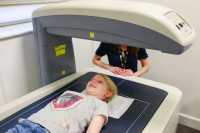Author Interviews, JAMA, Orthopedics, Pediatrics / 09.08.2019
Early Puberty Linked to Stronger Bones
MedicalResearch.com Interview with:
Dr Ahmed Elhakeem PhD
Senior Research Associate in Epidemiology
University of Bristol
MedicalResearch.com: What is the background for this study? What are the main findings?
Response: We know that the denser (stronger) your bones are, the less likely they are to break (fracture).
We also have reliable evidence that later maturing adolescents tend on average to have lower bone density than their earlier maturing peers.
We wanted to find out how the timing of puberty might influence the development of bone density throughout adolescence and into early adult life. We did this by following up a large group of young people born in the early 90s around Bristol, UK that took part in a unique study (the Children of the 90s study) that included repeated density scans over a 15-year period from age ten to 25.
We found that those later maturing adolescents that got their growth spurt at an older age tended to catch-up to some degree to their earlier maturing peers during puberty however, they continued on average to have lower bone density than average for several years into adulthood. (more…)




